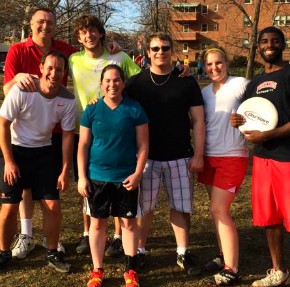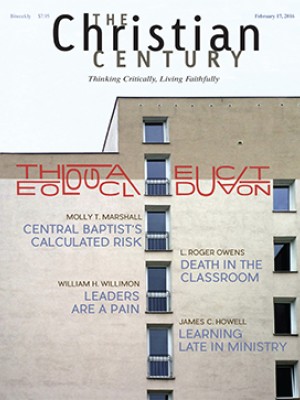Letting suffering in: How a colleague's death changed my teaching

I saw the e-mail with my faculty colleague’s name in the subject line while I was at my son’s baseball practice. The message said he had “collapsed playing Frisbee with students” on the seminary lawn. Later I learned that a student had administered CPR while the rest waited for the paramedics to arrive. After he was taken to the hospital, the students kept vigil in the chapel.
I kept my own vigil at home, washing dishes, checking my e-mail every few minutes until a second one arrived two hours after the first: Professor Johannes “Jannie” Swart had died. It was Monday, the first day of fall classes.
Jannie and I joined the faculty at the same time a year earlier, and we quickly became friends. He’d show up in my office to chat—and sometimes plot—for the pleasure of the exchange, but also to put off writing his book.
Jannie and I were the subcommittee charged with drafting the new goals for our M.Div. program, and Jannie had a clear sense of where the program should go. We should be doing theological reflection from within contexts of ministry, in the world, crossing dividing lines, he said, not getting our theology straight safely within the seminary’s iron perimeter fence and only applying it later.
Read our latest issue or browse back issues.
I can still see him, his hefty over-six-foot frame pressing into the little sofa in my office, his hands rubbing his buzz cut as he talks. His Mandela shirt and his Afrikaans accent gave away the source of his passion on this subject. As he said once, “I am a child of apartheid.”
His conversion came when he, a white South African, began visiting black townships on the outskirts of Johannesburg. There he learned, as he put it, to accept the hospitality of the other, of those who had been demonized. Eventually, Jannie became the pastor of one of South Africa’s large Dutch Reformed congregations. He arrived to lead a predominately white congregation; he left it a multicultural, multilingual community, worshiping in several languages, a symbol of hope in postapartheid South Africa.
“It’s good I can’t come to the meeting to discuss this draft next week. I’m too pushy. You are more diplomatic than me,” he said once, with his characteristic laugh. Jannie often left an empty soda bottle in my office as a memento of his visit.
I knew his witness would have a lasting impact on the way we thought about theological education as a seminary. What I didn’t anticipate was the way his death would challenge my own work in the classroom.
I was one of those people who thought of a seminary as an incubator, a place where we could take refuge from the world in the subject at hand. I was at least a little wistful for the days of cloistered seminaries, for students secluded for a few years in order to learn the things of God.
But Jannie’s death wouldn’t stay on the lawn. It came into the classroom the way Jannie used to come into my office. It sat down, ready to stay awhile. My course that term was on desert spirituality. Some of the students in the class had seen Jannie die. How could we talk about the dark night of the soul, of being stripped of our attachments, when we ourselves were fumbling in the dark?
The class took an unexpected direction. Our discussions turned from Jannie’s death to the deaths of black men at the hands of the police, which were all over the news.
The next term I was teaching a course on Thomas Merton and planned for us to read three of his books on contemplation and a couple of his essays on Buddhism. A week before the term started a grand jury chose not to indict the Ferguson police officer who killed Michael Brown. I changed my syllabus.
I remembered Merton had written about race and civil rights in the 1960s. His rejection of the world in the 1940s had, by the 1960s, become an embrace of the world’s pain. If from within his cloister he could embrace the world, so could we, I thought. I added to the syllabus several of Merton’s essays from the ’60s. In the context of increasing attention to police brutality and wider discussions of white privilege, I suspected that Merton’s claims—for instance, that the “problem is to eradicate the basic violence and injustice from white society”—would occasion rich discussion. And they did.
I wonder if I would have had the awareness to make this last-minute adjustment if Jannie’s death had not removed my blinders and if his vision of theological education radically engaged with a world God loves had not become lodged somewhere in me.
My lesson plan is no longer my tightly written script, which I try to perform as flawlessly as possible. I now see it as notes toward a discussion of what is transpiring in the community, the nation, and the world outside the seminar room. And what seems to be standing outside the door lately are the unjust ways our society delivers death.
On the evening of September 29 I arrived at my spiritual formation course with my lesson plan in hand. The subject—Merton again. We would be parsing his understanding of false self and true self, and asking how we see our own stories of faith in his account.
What wasn’t in the plan was Kelly Gissendaner. September 29 was the night the state of Georgia intended to execute her for her role in plotting her husband’s murder. The execution was scheduled for half an hour after the beginning of class.
Kelly’s story is well known. A conversion in prison turned Kelly into a model inmate and minister to the other women in jail. Kelly’s story began to work itself into my script: Which was Kelly’s true self—the murderer or the minister or, somehow, both? And what does it mean for Christians to live as true selves in a society that can see someone being renewed in God’s image and still subject them to the most premeditated killing?
I chose to improvise, to accept the request her story seemed to be presenting and see what happened. What happened were a few tears, some healthy disagreement, and a challenge to my way of reading Merton.
If Jannie were here I suspect he’d pat me on the back. “Good work, Roger,” I imagine him saying with a smile, pausing to sip his soda. “You’ve let the world into your classroom. Now it’s time to take your classroom into the world. Why not take your class to the state penitentiary? Do your theological reflection with those keeping vigil outside of death row and with those waiting to die within.” And then he would laugh, to indicate he’s both pleased and serious.
Eight months after Jannie died, students led a service of remembrance on the lawn where he collapsed. Over those months our mourning had not turned into dancing, but our lament was making room for other things, like gratitude and praise.
As I sat there on a black folding chair I remembered something Jannie said in one of his last public lectures. He said the church should laugh with the apostle Paul in the face of death and then “recommit ourselves to faithfulness in the face of God’s promises.”
Maybe Jannie was right—maybe learning to laugh at death is part of theological formation. If so, the laughing will not come until we’ve opened the door and let death in, let the suffering in, until, at the very least, it sits at the seminar table and we look it in the face, listen to its questions, and ask it our own.
And maybe not until we’ve left the seminar room ourselves and walked into the places of suffering and death the way Jannie journeyed into the black townships outside of Johannesburg. Someday we might laugh. I only hope my laugh will be as joyful as Jannie’s.





